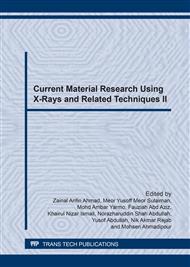[1]
H.H. Park, I.S. Park, K.S. Kim, W.Y. Jeon, B.K. Park, H.S. Kim, T.S. Bae, M.H. Lee, Bioactive and electrochemical characterization of TiO2 nanotubes on titanium via anodic oxidation, Electrochim. Acta, 55 (2010) 6109-6114.
DOI: 10.1016/j.electacta.2010.05.082
Google Scholar
[2]
V. Vega, M.A. Cerdeira, V.M. Prida, D. Alberts, N. Bordel, R. Pereiro, F. Mera, S. García, M. Hernández-Vélez, M. Vásquez, Electrolyte influence on the anodic synthesis of TiO2 nanotube arrays, J. Non-Cryst. Solids, 354 (2008) 5233-5235.
DOI: 10.1016/j.jnoncrysol.2008.05.073
Google Scholar
[3]
J.H. Lee, H.E. Kim, Y.H. Koh, Highly porous titanium (Ti) scaffolds with bioactive microporous hydroxyapatite/TiO2 hybrid coating layer, Mater. Lett. 63 (2009) 1995-(1998).
DOI: 10.1016/j.matlet.2009.06.023
Google Scholar
[4]
M.Y. Lan, S.L. Lee, H.H. Huang, P.F. Chen, C.P. Liu, S.W. Lee, Diameter selective behavior of human nasal epithelial cell on Ag-coated TiO2 nanotubes, Ceram. Int. 40 (2014) 4745-4751.
DOI: 10.1016/j.ceramint.2013.09.018
Google Scholar
[5]
T.H. Koo, J.S. Borah, Z.C. Xing, S.M. Moon, Y. Jeong, I.K. Kang, Immobilization of pamidronic acids on the nanotube surface of titanium discs and their interaction with bone cells, Nanoscale Res. Lett. 124 (2013) 1-9.
DOI: 10.1186/1556-276x-8-124
Google Scholar
[6]
W. Wang, L. Zhao, K. Wu, Q. Ma, S. Mei, P.K. Chu, Q. Wang, Y. Zhang, The role of integrin-linked kinase/β-catenin pathway in the enhanced MG63 differentiation by micro/nano-textured topography, Biomat. 34 (2013) 631-640.
DOI: 10.1016/j.biomaterials.2012.10.021
Google Scholar
[7]
B. Choudhury, M. Dey, A. Choudhury, Defect generation, d-d transition, and band gap reduction in Cu-doped TiO2 nanoparticles, Int. Nano Lett. 25 (2013) 1-8.
DOI: 10.1186/2228-5326-3-25
Google Scholar
[8]
P. Górska, A. Zaleska, E. Kowalska, T. Klimczuk, J.W. Sobczak, E. Skwarek, W. Janusz, J. Hupka, TiO2 photoactivity in vis and UV light: The influence of calcination temperature and surface properties, Appl. Catal., B Environ. 84 (2008) 440-447.
DOI: 10.1016/j.apcatb.2008.04.028
Google Scholar
[9]
Y. Lai, H. Zhuang, L. Sun, Z. Chen, C. Lin, Self-organized TiO2 nanotubes in mixed organic–inorganic electrolytes and their photoelectrochemical performance, Electrochim. Acta, 54 (2009) 6536-6542.
DOI: 10.1016/j.electacta.2009.06.029
Google Scholar
[10]
H. Habazaki, K. Shimizu, S. Nagata, P. Skeldon, G.E. Thompson, Fast migration of fluoride ions in growing anodic titanium oxide, Electrochem. Commun. 9 (5) (2007) 1222-1227.
DOI: 10.1016/j.elecom.2006.12.023
Google Scholar
[11]
S. Nakashima, H. Fujisawa, M. Shimizu, O. Sakata, T. Yamada, H. Funakubo, J.M. Park, T. Kanashima, M. Okuyama, X-ray diffraction study of electric-field-induced strains in polycrystalline BiFeO3 thin films at low temperatures by using synchrotron radiation, J. Korean Phys. Soc. 59 (2011).
DOI: 10.3938/jkps.59.2556
Google Scholar
[12]
S.H. An, R. Narayanan, T. Matsumoto, H.J. Lee, T.Y. Kwon, K.H. Kim, Crystallinity of anodic TiO2 nanotubes and bioactivity, J. Nanosci. Nanotechnol. 11 (2011) 4910-4919.
DOI: 10.1166/jnn.2011.4114
Google Scholar
[13]
L.M. Chamberlain, K.S. Brammer, G.W. Johnston, S. Chien, S. Jin, Macrophage inflammatory response to TiO2 nanotube surfaces, J. Biomater. Nanobiotechnol. 2 (2011) 293-300.
Google Scholar
[14]
W.Q. Yu, X.Q. Jiang, F.Q. Zhang, L. Xu, The effect of anatase TiO2 nanotube layers on MC3T3-E1 preosteoblast adhesion, proliferation, and differentiation, J. Biomed. Mater. Res. A. 94A(4) (2010) 1012-1022.
DOI: 10.1002/jbm.a.32687
Google Scholar


